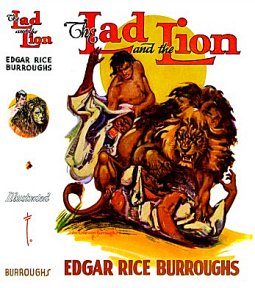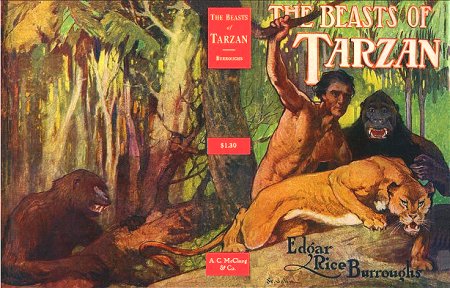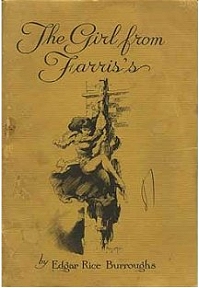
Official Edgar Rice Burroughs Tribute and Weekly Webzine Site
Since 1996 ~ Over 10,000 Web Pages in Archive
Presents
Volume 1705e
Themes And Variations
Springtime For Edgar Rice Burroughs
Part 6
Working Around The Blues
by R.E. Prindle

 |
 |
 |
Nineteen-fourteen dawned with ERB trying to work around his problems. As unbelievable as it may seem he wrote three stories in the first quarter of that year - The Beasts Of Tarzan, The Lad And The Lion and The Girl From Farris’s.Beasts probably relates to his continuing problems with Emma. Quite probably the wishes expressed in Nu Of The Niocene remained unfulfilled as Tarzan and Jane or ERB and Emma become estranged or separated in Beasts. The separation is reminiscent of the separation in Tarzan The Untamed, Tarzan The Terrible and Tarzan And The Golden Lion. Obviously something is going on in the marriage but apart from inferences in the novel we can’t be clear as to what. Suffice it to say the couple remains together.
Then in February ERB began what must have been a painful book for him to write. He began the book on 2/12/14 almost exactly one year after his father died. George T. passed away on 2/15/13. ERB had had a year to mull over his dad’s dieing and Lad is the result.
George T. appears to have been a difficult father for his sons, all of them, not just ERB. Except for ERB slipping the noose by becoming a writer none of the Burroughs Boys would have been a success in life by business standards.
The hangman’s noose is a minor theme in the stories of the teens appearing most significantly in Bridge And The Oskaloosa Kid. The noose also make an appearance on the 100th anniversary of George T.’s birth in 1933’s Tarzan And The Lion Man. While the noose was intended for Burroughs alter egos in the teens in Lion Man the situation is reversed when Tarzan/ERB places a noose around the neck of God/George T. Perhaps the strange piebald appearance of God reflects ERB’s love/hate relationship with his father.
Little study of George T. Burroughs has been done. But if we postulate the burning of his distillery as the central fact of his later life from which he never recovered but edged slowly downhill then the burning of God’s castle may possibly represent the burning of the distillery.
It is possible that the fire changed the personality of George T. He may have been one man before the fire and another after. It is significant that God/George T. is associated with cannibalism. Thus the theme of cannibalism that looms large in the corpus may be associated with ERB’s relationship with his father. Thus the noose and cannibalism would be symbols of ERB’s treatment by his father.
In Lad his father surrogate is a deaf mute crazy old coot who torments the Lad and his Anima every day of their lives. I am not clear on ERB’s relationship with his mother but let us compare a passage from Howard Pyle’s story of King Arther from Volume II The Story Of The Champions Of The Round Table which it is very probable Burroughs read and was influenced by:
So she (Percival’s mother) kept Percival always with her and in ignorance of all that concerned the world of knighthood. And though Percival waxed great of body and was beautiful and noble of countenance yet he dwelt there among those mountains knowing no more of the world that lay beyond that place in which he dwelt and the outer world, then would a little innocent child. Nor did he ever see anyone from the outside world, saving only an old man who was a deaf mute.Transfer the above setting to the deck of the derelict, make the old deaf mute vicious and mean and possible substitute the lion for the mother and you have transposed Percival to the Lad And The Lion.We don’t have enough information to be certain of the characters of George T. and Mary Evaline. ERB is reticent about his mother. Either I’m missing the key or she doesn’t appear in the stories. Not much has been said of her after her husband’s death in 1913 and her own death in April of 1920 while visiting in Tarzana. Prior to that she had been visiting her sons spending three months at a time with them. Whether she had just began this rotation is uncertain but this was the first time she had visited ERB and Emma.
George T. figures more largely in Burroughs’ writing while always in a love/hate relationship. I never had a father so I have that blind spot in my education meaning that, perhaps, I may not be the best judge of the father-son relationship. My evaluation of George T. is that he wished to maintain a dominant role over his sons. Perhaps, like many fathers, he was fearful that as his powers waned theirs would wax and they would become more powerful than he. Something along the lines of the Greek god Cronus who, having been warned that one of his offspring would replace him swallowed them whole as they were born. A stone was offered Cronus in place of his youngest son, Zeus, who did grow up to replace him.
It is interesting that George T.’s youngest son, ERB, was able to escape his meshes just as the father died.
The letters of the Burroughs Boys - George and Harry - from Yale indicate that while their father supported them he kept them on a short leash. It is true that they began college after the distillery fire so that he may have been more liberally handed before the fire so as to bind the Boys to him but we won’t know.
Having finished Yale as graduates of the Sheffield Scientific School they returned home to take up roles in the battery business that succeeded the distillery. They were only able to escape their father’s domination when Harry became ill from battery fumes requiring his living in the dry climate of the West. George begged to follow him and was so allowed.
George T. didn’t own the battery business outright in its first years. It would be nice to know something about his business associates in that business.
I have already detailed the difficulties he placed in ERB’s life that were detrimental to the formation of the lad’s character.
And then we have Herb Weston’s characterization of George T. as a stern man of the old school who he yes, sirred and no, sirred and got along with him famously.
It is not impossible that John Carter is the idealized character of ERB’s father. Carter’s own role in the Mars series does not disappear after 1913's Warlord Of Mars but his role is greatly curtailed. A possibility.
I think it is a near certainty that the deaf mute old coot of the derelict is the negative father. In Lad he doesn’t die naturally but is killed by the Lion who rips his face off. This must be an affect of his father’s death as after the Lion kills him the Lad and the Lion continue to drift along for several months before the ship gently beaches itself, the tide goes out and the two walk ashore. Then, just as Percival saw the knights, being drawn into the outside world, the Lad sees the Arab ‘knights’ being also drawn into the outside world. He experiments with the burnoose just as Percival experimented with the armor.
Thus a year after his father’s death Burroughs attempts to escape from the ‘crazy old coots’ shadow.
That done, ERB then turns to a story begun the previous May to finish it. The long period of incubation indicates the difficulty he had in getting the story out. The Girl From Farris’s tells of the period from his bashing in 1899 to his return from Idaho in 1904.
It is a difficult story vis-a-vis Emma. ERB places his heroine in a brothel in Chicago. Harris’s, the original location, was actually a famous brothel; Harris himself being a noteworthy figure which is probably why the name was changed to Farris’s.
The woman escapes from the brothel. After a series of adventures in Chicago she leaves for Idaho where she meets the hero Ogden Secor again who had aided her back home.
Secor is in a desperate psychological state and that is probably an accurate description of ERB’s state of mind during those few years.
The woman is identified and taken back to Chicago where after a bit of legal hoopla she is exonerated, we learn that she was never a prostitute and she and Secor are married. After this number of terrible years something good happens to Secor and, one assumes Burroughs, the ray of light breaking through the clouds.
At this point in March, nearly April, of 1914 ERB and the family return to Chicago, after once again auctioning off their belongings as they had done in Salt Lake City before returning to Chicago in 1904. This has to signify in Burroughs’ mind that he had reversed his shameful performance of ten years earlier. He undoubtedly expected Emma to also accept 1913-14 as a redemption of 1903-04. Just as he had gambled and lost in ‘03, in 1913-14 he had gambled and won.
Even though according to him he was living hand to mouth he ordered a new automobile (not a used Velie) for delivery upon his arrival back in Chicago. If the car was Burroughs’ Hudson then that would indicate that he had visited Baum in Hollywood as Baum drove a Hudson. ERB would want to emulate his hero. Then within a month or two the Burroughs left their old address in Chicago to move into the fancier suburb of Oak Park. Perhaps this move was made possible by the expected book royalties. Thus Burroughs continued to spend in anticipation of income rather than from money in his pocket. So Burroughs kept his hopes and dreams alive.
The springtime of ERB thus ended. The incredible psychological release of success was now to be tempered by new realities. The act of writing would now become a full time job. From 1911 to 1913 he wrote from hopes and dreams. Now he would have to settle down to turning out two or three books a year for magazine sales plus book royalties and newspaper royalties soon to be joined by movie revenues. ERB had won the gamble of quitting his day job. The Roving Gambler could now turn to the pleasures of life on the yacht.
But first there was the unfinished business of the three stories - The Mad King, The Cave Girl and The Eternal Lover - to be taken care of.
Properly belonging to 1913 the three sequels would take up a large block of time in 1914 which makes that year a transition year.
I will review the stories in the sequence in which they were written: The Cave Man July-August of 1914, The Eternal Lover, August and September and The Mad King, September-October.
Next: Part VII: The Denouements.
|
Cave Girl A Review |
Civilization And Its Discontents |
Renascent Burroughs - A Lover’s Question |
How Waldo Became A Man |
|
Entering Summer |
Working Around The Blues |
The Sequels |
From ERB's Library |
R. E. Prindle welcomes your comments at:
dugwarbaby@yahoo.com
|
and Follow the Navigation Chart for the Entire Series of Articles |
|
Differing viewpoints are welcome. |
|
are not necessarily those held by Edgar Rice Burroughs, Inc. |
![]()
![]()
![]()
![]()

![]()
BILL
HILLMAN
Visit
our thousands of other sites at:
BILL
AND SUE-ON HILLMAN ECLECTIC STUDIO
ERB
Text, ERB Images and Tarzan® are ©Edgar
Rice Burroughs, Inc.- All Rights Reserved.
All
Original Work ©1996-2007/2010 by Bill Hillman and/or Contributing
Authors/Owners
No
part of this web site may be reproduced without permission from the respective
owners.